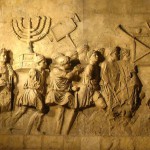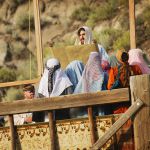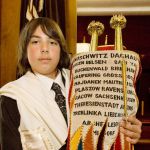
A Jewish boy lights multiple Hanukkah menorahs on the second night ofHanukkah, as a neon menorah glows in the background.
Today is the first day of Hanukkah. Last night, the first light of the hanukkiah was kindled in homes and public venues as this special holiday began.
As the sun sets here in Jerusalem, the second night of Hanukkah begins.
Perhaps the best-known custom of Hanukkah is the lighting of the hanukkiah, and tonight, all around the world, two candles will be lit on the hanukkiah (special Hanukkah menorah)!

Symbols of Hanukkah: the hanukkiah, sufganiyot (jam-filled donuts), gel (chocolate coins), and dreidels (tops).
This special menorah is used only at Hanukkah, and although it is reminiscent of the seven-branched light stand that stood in the Temple, it is different.
Instead of having seven branches like the Temple Menorah, the hanukkiah has eight candles, as well as a special candle called a shamash. Since the shamash is used to light all the other candles, it is considered to be the servant candle.
This ninth candle is most often elevated over the eight other candles in the hanukkiah and sometimes placed in the middle.
Since the second day of Hanukkah begins tonight, a second light will be added to the hanukkiah. With the shamash, there will be three lights glowing on the Hanukkah menorah.
On each night of Hanukkah, one additional candle is added to the hanukkiah. On the last night, the shamash lights all eight candles so that all of the lights shine together.
In addition to lighting the hanukkiah, it is also customary to read stories, spin the dreidel, sing Hanukkah songs, and eat foods fried in oil.
Sufganiyot (donuts), which are a favorite here in Israel, and latkes (potato pancakes) served with sour cream and applesauce, are two traditional Hanukkah foods.
As fattening as these deep fried foods are, they are prepared in order to memorialize the miracle God did in restoring the Temple in Jerusalemand saving the Jewish People from the Greek/Syrian army. (It’s all about the story of the olive oil!)

A Jewish girl eats a sufganiyah on Hanukkah. This fried food of Hanukkah memorializes the miracle of a one-day supply of holy oil burning for eight days while the Temple was rededicated.
Hanukkah: A Great Miracle Happened Here
The word Hanukkah comes from the Hebrew word hanukh, which means dedication or education.
Hanukkah is celebrated as the Feast of Dedication to remember the re-dedication of the Temple after God faithfully delivered Israel from her oppressors.
In fact, the reason for lighting eight candles is to present to Israel and the world a visual reminder of God’s faithfulness and the miraculous story of Hanukkah.
Between the years 175 to 163 BC, after the death of Alexander the Great, who had conquered and divided the entire ancient world of the Eastern Mediterranean, the area of Judea came under control of the Greek King Antiochus IV Epiphanes.
Antiochus tried to force the Jews to accept Greek culture. He even defiled the Beit HaMikdash (Temple in Jerusalem) by sacrificing a pig on the altar and desecrating this holy place with the blood of this unclean animal.
As described in the book of the Maccabees in the Apocrypha, this wicked ruler forbade the Jewish people from keeping God’s laws. In fact, the penalty for keeping the Torah was death. Many Jewish people chose martyrdom over defying God’s commandments.

Since the Greeks outlawed the study of the Torah, when someone approached, the Torah was hidden and dreidels were taken out and played like a game of chance. Their oppressors thought the Jewish people were playing a children’s game when they were actually pursuing the things of God. The letters nun, gimmel, hey, shin stand for nes gadol haya sham, meaning a great miracle happened there. In Israel, however, the letters are nun, gimmel, hey, pey meaning a great miracle happened here (poh).
Antiochus also erected a statue of the Greek false god, Zeus, in the Holy of Holies!
As horrible as this was, it fulfilled the Hebrew Prophet Daniel’s prophecy concerning the “abomination of desolation.”
The Prophet Daniel wrote: “His armed forces will rise up to desecrate the temple fortress and will abolish the daily sacrifice. Then they will set up the abomination that causes desolation. With flattery he will corrupt those who have violated the covenant, but the people who know their God will firmly resist him.” (Daniel 11:31–32)
A Jewish revolt against this assault on Judaism rose up led by the courageous freedom fighters called the Maccabees.
This name is an acronym standing for the Hebrew phrase Mi kamocha ba’elim Adonai, which means Who is like you, Lord, among the gods?

Delicious potato latkes served with generous dollops of sour cream and applesauce—a real Hanukkah delight!
Although greatly outnumbered and overpowered, Yehudah (Judah) the Maccabee led his brothers and some other Jewish men in a valiant battle to drive out tens of thousands of Greeks and reclaim the Temple.
God helped this small but courageous group of men to win the victory in 163 BC, taking back Jerusalem and rededicating the Temple to God.
Jewish law requires the Temple Menorah to stay lit 24 hours a day using consecrated oil, but tradition has it that they only found a one-day supply of sealed, consecrated oil; however, the oil miraculously burned for a whole eight days—the time it took to prepare the sanctified oil for lighting the Menorah every day after.

The most common tradition at Hanukkah is lighting the hanukkiah. It is lit in remembrance of the eight days that the Golden Menorah in the Holy Temple kept burning on a one-day supply of oil.
Yeshua: the Shamash Who Kindled the Light in Our Hearts and Lives
“For even the Son of Man came not to be served, but to serve, and to give His life as a ransom for many.” (Mark 10:45)
Since Hanukkah is not a holiday ordained by God in the Torah, some wonder if Yeshua (Jesus) actually celebrated it.
The answer is a resounding yes!
“It was winter, and the Festival of the Dedication was being held in Jerusalem. Yeshua was walking in the Temple precincts, in Solomon’s Portico. The Jews gathered round Him and asked: ‘How long must you keep us in suspense? If you are the Messiah say so plainly.’” (John 10:22–24)
Yeshua went to Jerusalem for the Feast of Dedication (Hanukkah), and while in the Temple area He proclaimed, “I and the Father are one.” (John 10:30)

Shamash: Yeshua the Messiah, like the shamash candle, kindles the light in our hearts and brings us out of darkness into the light of life.
Just as the shamash on the hanukkiah is the servant candle that lights the other eight candles, Yeshua the Messiah came as a servant to be the light that shines in and through us to others.
John confirms that Yeshua is the light that darkness cannot overcome.
“In Him was life, and that life was the light of all mankind. The light shines in the darkness, and the darkness has not overcome it.” (John 1:4–5)
Darkness has no power over the light. When the lights are turned on, the darkness disappears immediately! It’s never a struggle or a contest. Light wins every time!
“When Yeshua spoke again to the people, He said, ‘I am the light of the world. Whoever follows Me will never walk in darkness, but will have the light of life.’” (John 8:12)

Israeli children gather around the recreated Temple Menorah, which is on display in Jerusalem. The Temple Institute created this Menorah for use in the Third Temple, which will inevitably by built.
The Significance of the Menorah
When the Holy Temple was restored during the time of the Maccabees, the act of re-lighting the Menorah in the Temple represented restoring God’s presence there.
The Temple was set up so that the Jewish people would have a place to come and meet with God. And while the Menorah was placed inside the Holy Place, the Jewish sages teach that the windows in the Sanctuary walls were no ordinary windows:
“For what is normally considered the function of windows? To let the light in. But these windows were in order to let the light the out—to disseminate the spiritual light emanating from the Temple Menorah out into the world. The Sanctuary’s windows allowed the special ethereal light coming forth from the Menorah to burst out to the world from within the hallowed hall.” (Temple Institute)
While the Bible makes it clear that the Temple will once again be rebuilt, today, those who know Yeshua do have spiritual light and are the dwelling place for the Holy Spirit (Ruach HaKodesh).
“Don’t you know that you yourselves are God’s temple and that God’s Spirit dwells in your midst?” (1 Corinthians 3:16)
Without the presence and Light of God shining on us, we are all lost. Moreover, without the presence and Light of God shining in us and out from us, we cannot minister His Good News of saving grace to others.















